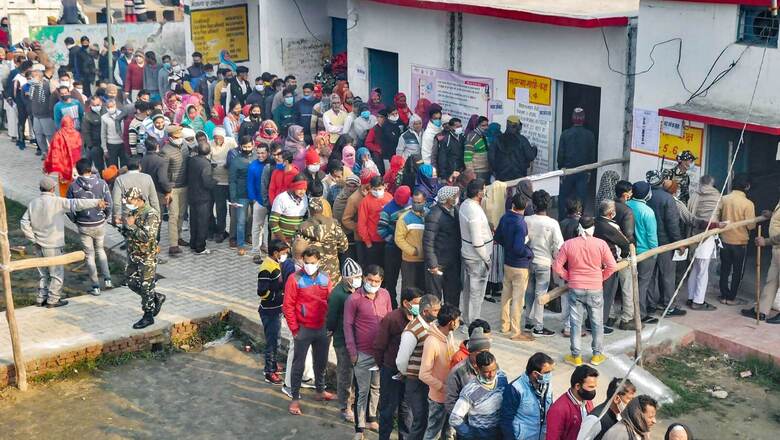
views
As parts of western UP and Ruhelkhand region head for polling in the second phase of Uttar Pradesh elections on Monday, 55 Assembly constituencies in play will most likely see a direct contest between the ruling BJP and the Samajwadi Party-Rashtriya Lok Dal alliance.
The region has the highest number of Muslim voters and also has a sizeable presence of OBC population. However, unlike Jat dominance in the first phase of polling in Uttar Pradesh elections, different OBC and MBC castes have varying presence across the districts.
This is the region where Akhilesh Yadav’s SP performed the best in 2017. Out of its total tally of 47 MLAs, 15 were from this region. In the 2019 Lok Sabha elections, too, the SP-BSP alliance had managed to put up a potent challenge to the BJP. Out of nine Lok Sabha constituencies, the BJP lost six. The SP and BSP had won three each.
The districts that are voting on February 14 are Saharanpur, Bijnor, Sambhal, Rampur, Bareilly, Badaun, Shahajahanpur, Amroha and Moradabad. Muslim population in this region ranges from 30% to 44% in certain districts. It’s no surprise then that the highest number of Muslim candidates from SP, Congress and the BSP are in this phase and region.
In all, 79 Muslim candidates are in the electoral race, including the lone Muslim candidate from the BJP-led National Democratic Alliance. Hamza Ali Khan is contesting on BJP ally Apna Dal’s ticket in Swar Tanda seat against SP’s Abdullah Azam Khan, the son of Azam Khan.
Muslim Votes
In 2017 Assembly elections, Muslim votes were split in the region with the BSP and the SP-Congress alliance actively wooing the community. This split helped ensure BJP victory on crucial seats in districts like Bijnor, Moradabad, Sambhal, Rampur and Amroha.
The BJP had won three out of four seats in Amroha, a district with overall population of around 35% Muslim votes. In Bijnor, it had won six seats, and won two in Moradabad. It won two seats each in Sambhal and Rampur. All these districts have 32 to 44% Muslim population.
This time around, the SP has strongly banked on Muslim faces in some key districts. The party has fielded Muslim candidates in all six constituencies of Moradabad — Kanth, Thakurdwara, Moradabad Dehat, Moradabad Nagar, Kundarki and Bilari. The BSP and Congress have each given five tickets to Muslims here.
Out of five Assembly segments in Rampur, the SP has fielded three Muslim candidates, including its jailed leader Azam Khan from Rampur and his son Abdullah Azam from Swar Tanda. The Congress and BSP have each fielded two Muslims leaders.
In Amroha, sitting SP MLA Mehboob Ali is again in the electoral fray. He is being challenged by Nadez Ayaj of the BSP and Saleem Khan of the Congress. The BJP has put up Ram Singh, hoping for a division of Muslim votes this time.
In the eight seats in Bijnor, the SP has fielded two Muslim candidates. The party is hoping that around 11% Jats along with other OBC communities offer crucial support. The BSP has fielded four Muslims in the district.
The SP has changed tack in the Deoband constituency of Saharanpur, which houses the Islamic seminary Darool Ulum Deoband and has around 1 lakh Muslim votes. The party had initially given a ticket to a Muslim candidate here, but brought in Kartikeya Rana as replacement. The Congress and AIMIM have fielded Muslim candidates here.
The SC/OBC Factor
Phase 2 elections are also in interesting case study of the OBC and MBC equation. Unlike Phase 1 where the Jat factor was influential, different OBC communities hold significance in different regions in the second phase.
From Saharanpur in the west to Badaun, Bareilly and Shahjahanpur in the east, OBC and Dalit votes differ in their sub-caste configuration. In Saharanpur, the core Jatav-Dalit vote-bank often considered close to the BSP, is estimated to be around 17%, while OBC minus the Jats constitutes around 17%.
Maurya, Kushwaha, Saini and Gurjar OBC communities dominate here. The BJP has given a lot of emphasis to this region with Prime Minister Narendra Modi and Union Home Minister Amit Shah visiting the district before polls.
In Bijnor, SP-RLD are banking on around 11% Jat voters. The region also has around 13% Jatav Dalits and 10% MBC voters, comprising mainly the Mauryas and the Kushwahas. Amroha, too, has 13% Jatava Dalits and 7% Jat OCB voters. But the area also has a sizeable presence of Maurya, Shakyas and Gurjars, and together they comprise around 15% of the voters.
The district of Badaun, with highest population of Yadav and Ahir voters, is naturally one of high hopes for the Samajwadi Party. Traditionally seen as SP stronghold, the party suffered setbacks here in the 2019 General Elections and before that in the 2017 Assembly polls, primarily due to the consolidation of non-Yadav OBC and Dalits. The split in Muslim and Yadav votebanks also hurt its chances. This time around, the SP will hope for bigger consolidation of the Yadavs and around 22% Muslims in the region.
Bareilly and Shahjahanpur are bigger strengths for the BJP. In 2017, the BJP won all six seats in Bareilly and bagged five out of six in Shahjahanpur. In the Bareilly region, the OBC Kurmi, Patel, Maurya and Kushwaha communities constitute around 30% of the population. These have been strongly with the BJP since 2014. In Shahjahanpur, the kisan and Lodhi communities have a sizable presence. OBC population spread across the constituencies is estimated to be around 32%. Muslims constitute 19% of the total population.
Read all the Latest Politics News here




















Comments
0 comment